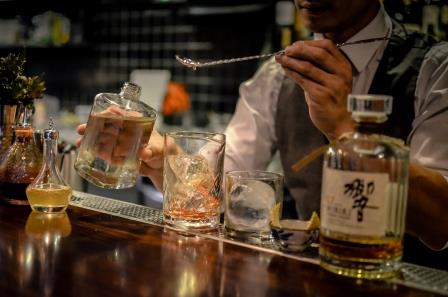Jacob Stern takes an in depth look at the newest behemoth in the whisky game – Japan.
The hum around Japanese whisky is growing undeniably louder, as an increasing number of consumers, merchants and critics join in chorus to sing the praises of the nation’s distillers. The steady stream of awards has certainly strengthened Japan’s credibility as a whisky producer, but for those inside the industry, these awards have merely served to reinforce what they have long known – Japanese whiskies are among the best in the world.
The feather in the cap moment arrived when Jim Murray, whisky critique and author of the annual Whisky Bible, named the Yamazaki Single Malt Sherry Cask 2013 as his whisky of the year leading into 2015. Although many disagreed, and argued strongly against his methods of selection, there is no doubt that his choice is reflective of the times we are in. Japanese whiskies have paid their dues and now they are reaping the rewards.
It is Sukhinder Singh, co-founder of the largest online whisky retailer, The Whisky Exchange, who puts it best, “Japanese whisky is, in simple English, on fire”.
HUMBLE BEGINNINGS
Japanese whisky has a rich history, beginning with suggestions that whisky – of some shape and form – was available in Japan as early as the eighteen hundreds.
Although the drink may have been in circulation for years, the first Japanese distillery was not officially opened until 1923. The Yamazaki distillery (now under the Suntory banner) was founded by Shinjiro Torii, a former importer of liquor from the West, who had the desire to create a local whisky tailored to Japanese tastes.
As it turned out, Japanese tastes would be forced to mirror Scottish ones, at least initially. Torii employed a Scottish-trained master blender, Masataka Taketsuru, meaning many of the practices and traditions he picked up abroad were brought to Japan. The relationship between Scottish and Japanese whiskies is no more evident than in their spellings of the word – both drop the ‘e’ from whisky, in contrast with other nations that produce the spirit. Taketsuru eventually left Yamazaki to go out on his own, establishing the distilling company now known as Nikka. Given that Japan’s two most recognised distillers have their roots in Scottish practices; it is no surprise that comparisons are often drawn.
GROWING UP
In Japan, whisky companies generally own both the distilleries and the product brands, allowing for greater product exclusivity – a stark contrast to the Scottish industry.
Scottish distilleries typically have a sole focus, and excess produce is passed on to other distilleries in order to create blended whiskies. For the Japanese companies, the desire to keep operations and products in-house has led to increased innovation and more diverse production.
As whisky grew locally, so did the demand for products that were tailored specifically to the Japanese palate. This led to lighter, sweeter whiskies that are easier to drink, comparable – only just – to more floral Highland whiskies or gentler Speyside drops.
Chiharu Tomizawa, chief bartender at Sydney establishment Tokonoma, finds, “Nikka to be a little more ‘traditional’ in that it mirrors Scottish whisky more so than other Japanese whiskies. Whereas Suntory produce what I would say is a truly unique Japanese whisky due to their methods and experimentation with select barrel finishes”.
For a long time Japanese whiskies were distributed almost exclusively in local channels. It was not until 1990 that Suntory broke into the US market with a solitary offering. From that point on Japanese whiskies have slowly been imbedding themselves in international markets, gaining in both repute and popularity. In 2003 the Yamazaki 12 Year Old won the gold medal at the International Spirits Challenge, removing once and for all the stigma that good whiskies exclusively originate in Scotland and Ireland. With the purists finally sitting up and paying attention to Japanese whiskies, it became a forgone conclusion that the general public would follow suit.
Stay tuned for part two of Japanese Whisky 101 next week…

